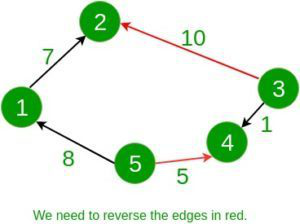给定一个连通的有向图。每个节点正好连接到另外两个节点。与每条边相关的权重表示反转其方向的成本。任务是找到反转图的某些边的最小成本,以便可以从每个节点到每个其他节点。
例子:
Input:
5
1 2 7
5 1 8
5 4 5
3 4 1
3 2 10
Output: 15
Input:
6
1 5 4
5 3 8
2 4 15
1 6 16
2 3 23
4 6 42
Output: 39方法:
- 为了从每个节点到达每个其他节点,该图必须形成一个环,即沿顺时针或逆时针方向的 2 个方向之一定向其上的所有边。让我们将所有顺时针边缘重定向到逆时针方向的成本表示为 cost1,反之亦然为 cost2。答案显然是这两个成本中的最小值。
- 维护两个布尔数组开始和结束。 start 和 end 数组表示是否存在从给定节点开始或结束的边。每当我们遇到从节点 a 到节点 b 的边时,我们首先检查条件是否存在从节点 a 开始或在节点 b 结束的边。如果存在满足条件的边,则该边与已经存在的边方向相反。在这种情况下,我们更新 cost2 并将边缘存储在相反的方向。否则,我们更新cost1。这样我们就能够维持两个方向的成本。最后,打印最低成本。
下面是上述方法的实现:
C++
// C++ code to find
// the minimum cost to
// reverse the edges
#include
using namespace std;
// Function to calculate
// min cost for reversing
// the edges
int minCost(vector >& graph, int n)
{
int cost1 = 0, cost2 = 0;
// bool array to mark
// start and end node
// of a graph
bool start[n + 1] = { false };
bool end[n + 1] = { false };
for (int i = 0; i < n; i++) {
int a = graph[i][0];
int b = graph[i][1];
int c = graph[i][2];
// This edge must
// start from b and end at a
if (start[a] || end[b]) {
cost2 += c;
start[b] = true;
end[a] = true;
}
// This edge must
// start from a and end at b
else {
cost1 += c;
start[a] = true;
end[b] = true;
}
}
// Return minimum of
// both possibilities
return min(cost1, cost2);
}
// Driver code
int main()
{
int n = 5;
// Adjacency list representation
// of a graph
vector > graph = {
{ 1, 2, 7 },
{ 5, 1, 8 },
{ 5, 4, 5 },
{ 3, 4, 1 },
{ 3, 2, 10 }
};
int ans = minCost(graph, n);
cout << ans << '\n';
return 0;
} Java
// Java code to find the minimum cost to
// reverse the edges
class GFG
{
// Function to calculate min cost for
// reversing the edges
static int minCost(int[][] graph, int n)
{
int cost1 = 0, cost2 = 0;
// bool array to mark start and
// end node of a graph
boolean []start = new boolean[n + 1];
boolean []end = new boolean[n + 1];
for (int i = 0; i < n; i++)
{
int a = graph[i][0];
int b = graph[i][1];
int c = graph[i][2];
// This edge must start from b
// and end at a
if (start[a] || end[b])
{
cost2 += c;
start[b] = true;
end[a] = true;
}
// This edge must start from a
// and end at b
else
{
cost1 += c;
start[a] = true;
end[b] = true;
}
}
// Return minimum of both possibilities
return Math.min(cost1, cost2);
}
// Driver code
public static void main(String[] args)
{
int n = 5;
// Adjacency list representation
// of a graph
int [][]graph = {{ 1, 2, 7 },
{ 5, 1, 8 },
{ 5, 4, 5 },
{ 3, 4, 1 },
{ 3, 2, 10 }};
int ans = minCost(graph, n);
System.out.println(ans);
}
}
// This code is contributed by Rajput-JiPython3
# Python code to find the minimum cost to
# reverse the edges
# Function to calculate min cost for
# reversing the edges
def minCost(graph, n):
cost1, cost2 = 0, 0;
# bool array to mark start and
# end node of a graph
start = [False]*(n + 1);
end = [False]*(n + 1);
for i in range(n):
a = graph[i][0];
b = graph[i][1];
c = graph[i][2];
# This edge must start from b
# and end at a
if (start[a] or end[b]):
cost2 += c;
start[b] = True;
end[a] = True;
# This edge must start from a
# and end at b
else:
cost1 += c;
start[a] = True;
end[b] = True;
# Return minimum of both possibilities
return min(cost1, cost2);
# Driver code
if __name__ == '__main__':
n = 5;
# Adjacency list representation
# of a graph
graph = [[ 1, 2, 7 ],
[ 5, 1, 8 ],
[ 5, 4, 5 ],
[ 3, 4, 1 ],
[ 3, 2, 10 ]];
ans = minCost(graph, n);
print(ans);
# This code is contributed by 29AjayKumarC#
// C# code to find the minimum cost to
// reverse the edges
using System;
class GFG
{
// Function to calculate min cost for
// reversing the edges
static int minCost(int[,] graph, int n)
{
int cost1 = 0, cost2 = 0;
// bool array to mark start and
// end node of a graph
Boolean []start = new Boolean[n + 1];
Boolean []end = new Boolean[n + 1];
for (int i = 0; i < n; i++)
{
int a = graph[i, 0];
int b = graph[i, 1];
int c = graph[i, 2];
// This edge must start from b
// and end at a
if (start[a] || end[b])
{
cost2 += c;
start[b] = true;
end[a] = true;
}
// This edge must start from a
// and end at b
else
{
cost1 += c;
start[a] = true;
end[b] = true;
}
}
// Return minimum of both possibilities
return Math.Min(cost1, cost2);
}
// Driver code
public static void Main(String[] args)
{
int n = 5;
// Adjacency list representation
// of a graph
int [,]graph = {{ 1, 2, 7 },
{ 5, 1, 8 },
{ 5, 4, 5 },
{ 3, 4, 1 },
{ 3, 2, 10 }};
int ans = minCost(graph, n);
Console.WriteLine(ans);
}
}
// This code is contributed by PrinciRaj1992Javascript
输出:
15时间复杂度: O(N),其中 N 是边数
如果您希望与专家一起参加现场课程,请参阅DSA 现场工作专业课程和学生竞争性编程现场课程。